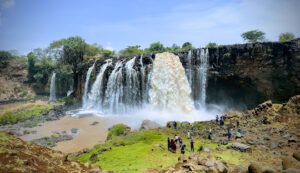
Ethiopia, a country rich in colorful culture and ancient history, has experienced a remarkable shift in recent years. Ethiopia, which was formerly seen to be a small and destitute nation, has grown to become a major role on the African scene and an economic force. The culmination of this incredible change came in 2022 when Ethiopia received an official invitation to become a member of the BRICS alliance, which is a powerful confederation of developing nations that also comprises South Africa, Brazil, Russia, India, and China. An important turning point in Ethiopia’s rise to prominence in the world economy is this invitation.
Ethiopia’s amazing resilience and unrelenting drive have determined its road to greatness. The nation has had several difficulties, such as natural catastrophes, conflict, and poverty. The famine that struck in 1984–1988 and left an estimated 800,000 people dead served as a stark reminder of the nation’s vulnerabilities. Another obstacle was Eritrea’s independence. Nonetheless, the Ethiopian people have continuously shown their everlasting dedication to advancement and tenacious spirit.
Land ownership in Ethiopia is difficult
According to the Ethiopian constitution, only “the state and the people” are entitled to own land; however, citizens are only allowed to lease it for a maximum of 99 years and are not allowed to mortgage or sell it. It is anticipated that allowing land to be rented out for a maximum of twenty years will guarantee that the land is used by the most productive user. The distribution and management of land is thought to be an area where corruption is institutionalized, and when resolving land-related issues, bribes and facilitation payments are frequently requested. As there is no land ownership, infrastructural projects are most often done without asking the land users, resulting in displaced and without a home or land. A lot of anger and distrust sometimes results in public protests. In addition, agricultural productivity remains low, and frequent droughts still beset the country, also leading to internal displacement.
Post 1991 development.
Before 1991, Ethiopia’s economy was largely agrarian, with a limited industrial base. However, following the adoption of a market-oriented economic system in 1991, the country has witnessed significant growth in its industrial sector. In the early years following the economic reforms, Ethiopia focused on creating a conducive environment for industrial development. The government introduced various policies aimed at attracting foreign investment, promoting private sector participation, and developing industrial infrastructure. These efforts, including the establishment of Industrial Parks and the implementation of the Growth and Transformation Plan (GTP), laid the foundation for the growth of the manufacturing sector, which began to expand in the late 1990s and early 2000s.
Ethiopian industry
The manufacturing sector has become a significant driver of Ethiopia’s economic growth in recent years. The sector has witnessed a rapid expansion, with its contribution to GDP increasing from 4% in 1992 to 19% in 2020. This growth has been fueled by a combination of factors, including:
- Favorable government policies: The government has continued to implement policies that support the growth of the manufacturing sector, such as tax incentives, access to finance, and the establishment of Special Economic Zones (SEZs). These SEZs, such as the Hawassa Industrial Park and the Dire Dawa Industrial Park, offer tax breaks, duty-free imports, and simplified customs procedures to attract foreign investment and boost manufacturing activities.
-
Abundant labor resources: Ethiopia has a large and young population, providing a plentiful supply of labor for the manufacturing sector. The country’s labor force is also relatively low-cost compared to other African countries, making it an attractive location for labor-intensive industries.
-
Strategic location: Ethiopia’s location in the Horn of Africa makes it a strategic hub for trade and investment, providing access to a growing regional market and facilitating exports to international markets, particularly in Europe and the United States. The country’s proximity to the Suez Canal, a major global shipping route, further enhances its strategic advantage.
What Ethiopia can give to BRICS
Ethiopia is rich in natural resources, including minerals, metals, and agricultural land. This can help BRICS countries meet their growing demand for resources.
Agriculture has long been the backbone of Ethiopia’s economy, employing over 70% of the population and contributing significantly to the country’s GDP. The fertile lands, diverse agroecological zones, and favorable climate conditions have made Ethiopia an agricultural powerhouse in Africa. The country’s agricultural output includes a wide range of crops, such as cereals (teff, maize, wheat, and sorghum), pulses (lentils, beans, and chickpeas), oilseeds (rapeseed, soybeans, and sunflower), coffee, and flowers. Ethiopia is also a major producer of livestock, with cattle, sheep, goats, and poultry playing a crucial role in food security and income generation. In recent years, the Ethiopian government has implemented various initiatives to modernize the agricultural sector, including promoting irrigation, introducing improved crop varieties, and expanding access to agricultural inputs and finance. These efforts have contributed to increased agricultural productivity and improved food security.
Ethiopia’s coffee industry is deeply rooted in its history and culture, making it one of the most significant sectors of the country’s economy. With over 60% of the population relying on coffee for their livelihood, Ethiopia is the world’s fifth-largest coffee producer and Africa’s top producer. The country’s coffee beans are renowned for their rich aroma, distinctive flavor, and high quality, making them highly sought-after in international markets. Ethiopia is also considered the birthplace of coffee, with its origin tracing back to the ancient Kaffa region, where legend has it that a goat herder named Kaldi discovered the invigorating effects of coffee berries.
Ethiopia needs investment
Ethiopia’s infrastructure development has lagged behind its economic growth, creating a bottleneck that hinders further progress. The country’s transportation network, including roads, railways, and ports, is underdeveloped and in need of significant investment. This limits the movement of goods and people, increasing transportation costs and hindering economic activity. The electricity grid is also insufficient to meet the growing power demand, causing frequent outages and hampering industrial production. Access to clean water and sanitation is also limited, particularly in rural areas, posing health risks and affecting the quality of life for millions of Ethiopians. Bridging this infrastructure gap requires substantial capital injections, both from domestic sources and international financing.



